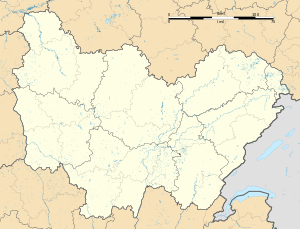Aisy-sous-Thil
| Aisy-sous-Thil | |
|---|---|
| Commune | |
 Aisy-sous-Thil Location within Bourgogne-Franche-Comté region  Aisy-sous-Thil | |
| Coordinates: 47°23′39″N 4°17′18″E / 47.3942°N 4.2883°ECoordinates: 47°23′39″N 4°17′18″E / 47.3942°N 4.2883°E | |
| Country | France |
| Region | Bourgogne-Franche-Comté |
| Department | Côte-d'Or |
| Arrondissement | Montbard |
| Canton | Semur-en-Auxois |
| Intercommunality | Terres Auxois |
| Government | |
| • Mayor (2014-2020) | Véronique Illig |
| Area1 | 8.3 km2 (3.2 sq mi) |
| Population (2014)2 | 232 |
| • Density | 28/km2 (72/sq mi) |
| Time zone | UTC+1 (CET) |
| • Summer (DST) | UTC+2 (CEST) |
| INSEE/Postal code | 21007 /21390 |
| Elevation |
313–387 m (1,027–1,270 ft) (avg. 357 m or 1,171 ft) |
|
1 French Land Register data, which excludes lakes, ponds, glaciers > 1 km2 (0.386 sq mi or 247 acres) and river estuaries. 2 Population without double counting: residents of multiple communes (e.g., students and military personnel) only counted once. | |
Aisy-sous-Thil is a commune in the Côte-d'Or department in the Bourgogne region of eastern France.
Geography
Aisy-sous-Thil is about 35 km south-east of Avalon and about 25 km south of Montbard. The Route d'Avalon, (Highway D70) passes directly through the heart of the commune from Avalon in the west to Vitteaux in the east although it does not pass through the village. The village is north of the D70 and can be reached by the Highway D15J off the D70. The Highway D15J passes out of the commune to the south-west and links to Lacour-d'Arcenay. Highway D980 also links with the D70 in the south-east corner of the commune. Highway D36 proceeds north out of the commune. The Autoroute du Soleil (A6/E15) passes about 2 km to the east of the commune. Most of the commune is farmland with some forests in the south-west and north-west. The village of Pont d'aisy is the only other village in the commune—to the south-east of Aisy-sour-Thil village.
The Serein stream forms the eastern border of the commune and the Portrait Stream forms the southern border. There are several ponds in the commune the largest of which is the Etang de Sarmeaux near the D15J south-west of the town.[1]
Administration
List of Successive Mayors of Abitain
| From | To | Name | Party | Position |
|---|---|---|---|---|
| 2001 | 2014 | Lionel Julienne | PS |
(Not all data is known)
Demography
In 2010, the commune had 101 inhabitants. The evolution of the number of inhabitants is known through the population censuses conducted in the town since 1793. From the 21st century, a census of municipalities with fewer than 10,000 inhabitants is held every five years, unlike larger towns that have a sample survey every year.[Note 1] [Note 2]
| 1793 | 1800 | 1806 | 1821 | 1831 | 1836 | 1841 | 1846 | 1851 |
|---|---|---|---|---|---|---|---|---|
| 472 | 357 | 350 | 408 | 408 | 404 | 427 | 510 | 487 |
| 1856 | 1861 | 1866 | 1872 | 1876 | 1881 | 1886 | 1891 | 1896 |
|---|---|---|---|---|---|---|---|---|
| 529 | 565 | 558 | 542 | 500 | 372 | 373 | 379 | 353 |
| 1901 | 1906 | 1911 | 1921 | 1926 | 1931 | 1936 | 1946 | 1954 |
|---|---|---|---|---|---|---|---|---|
| 338 | 335 | 306 | 250 | 228 | 246 | 220 | 218 | 263 |
| 1962 | 1968 | 1975 | 1982 | 1990 | 1999 | 2006 | 2007 | 2008 |
|---|---|---|---|---|---|---|---|---|
| 250 | 277 | 336 | 236 | 229 | 220 | 213 | 102 | 101 |
| 2009 | 2010 | 2011 | 2012 | 2014 | 2015 | 2016 | 2017 | 2018 |
|---|---|---|---|---|---|---|---|---|
| 101 | 101 | - | - | - | - | - | - | - |
From 1962 to 1999 there was no double counting of people who stayed in multiple communes.
Personalities
- Edith Royer, founder of the Brotherhood "Prayer and Penance" of Montmartre, was born in the commune.
See also
Notes and references
Notes
- ↑ At the beginning of the 21st century, the methods of identification have been modified by law No. 2002-276 of 27 February 2002 Archived 2016-03-06 at the Wayback Machine., the so-called "law of local democracy" and in particular Title V "census operations" which allow, after a transitional period running from 2004 to 2008, the annual publication of the legal population of the different French administrative districts. For municipalities with a population greater than 10,000 inhabitants, a sample survey is conducted annually, the entire territory of these municipalities is taken into account at the end of the period of five years. The first "legal population" after 1999 under this new law came into force on 1 January 2009 and was based on the census of 2006.
- ↑ In the census table and the graph, by convention in Wikipedia, and to allow a fair comparison between five yearly censuses, the principle has been retained for subsequent legal populations since 1999 displayed in the census table and the graph that shows populations for the years 2006, 2011, 2016, etc., as well as the latest legal population published by INSEE
References
- ↑ Google Maps
- ↑ Ldh/EHESS/Cassini until 1962
- ↑ Local INSEE 1968 INSEE
External links
| Wikimedia Commons has media related to Aisy-sous-Thil. |